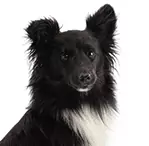
Meet the Shetland Sheepdog
Best Fur Friend
High Doggy I.Q.
Protective Pooch
My Many Looks
My Breed Characteristics
Furbulous Fact
As I Grow Up
History of My Breed
Care Tips
Training Tips
Personality
Gentle
Playful
Loyal
Group
Herding Group
Origin
Shetland Islands, Scotland
Life Span
12-14 Years
Breed Popularity
#27 of 195
Height Range
13-16 Inches
Weight Range
15-25 Pounds
Coat Details
Type
Long
Texture
Straight Coarse Outer Coat and Short Dense Undercoat
Features
Double Coat
Colors
Black & White; Black, White & Tan; Blue Merle & White; Blue Merle, White &am
Hypoallergenic
Cost to Buy
$500-$1,285
Lifetime Care Cost
$16,355
My Many Looks
My Breed Characteristics
Furbulous Fact
As I Grow Up



History of My Breed
Care Tips
from Dr. Jessica Greenberg, Associate VeterinarianPurchase from a responsible breeder.
While well bred and cared for Shetland Sheepdogs can be very healthy, this breed is susceptible to certain heritable joint disorders, including hip dysplasia, patellar luxation, and Legg-Perthes, which can cause pain and loss of mobility. In addition to heritable joint conditions, some Shetland Sheepdogs are also predisposed to a variety of genetic eye conditions that can cause blindness, including trichiasis, progressive retinal atrophy (PRA), cataracts, and Collie eye anomaly. Avoid heartbreak and veterinary expenses by purchasing puppies from responsible breeders who only breed dogs that are free of heritable disorders and provide health guarantees.
Keep an eye out for skin problems.
Dermatomyositis is a skin condition seen in Shetland Sheepdogs that causes hair loss and skin crusting on the face, ear tips, legs, tip of tail, and feet. The condition can be seen in puppies as young as 12 weeks of age. Dermatomyositis is believed to be caused by a combination of genetic and environmental factors, including stress. Consult your vet if you notice any of these symptoms.
Steer clear of ivermectin.
Some Shetland Sheepdogs may have a hypersensitivity to ivermectin due to a MDR1 genetic mutation, leading to the phrase ‘white feet, don’t treat’. To be safe, do not give Shetland’s ivermectin. This includes heartworm prevention that uses ivermectin as an active ingredient.
Training Tips
from Dr. Jessica Greenberg, Associate VeterinarianTeach them to be calm around loud noises.
Shetland Sheepdogs are highly responsive and startle easily. A loud truck or unexpected doorbell can cause them to jump. Your impulse will be to comfort them – don’t do that. Just model calmness. If you don’t react to the noise, you demonstrate that it is nothing to worry about. This will help your sheepdog relax themselves. If you become responsive to the noise yourself, that will exacerbate their anxiety.
Mental stimulation is key.
As sheepdogs, Shelties are happiest when herding. You may think all they need is physical exercise, but the truth is they crave mental stimulation as well. These are dogs that can learn advanced tricks, agility training, and other special skills. They’ll thrive when they do so and become anxious wrecks if their brains are ignored.
Discourage their barking.
Shetland Sheepdogs are notorious for their constant barking. This is part of who they are, but that behavior is encouraged if you leave them alone for long periods of time, respond to their barking, or don’t stimulate them enough. Make sure to ignore the bark and avoid situations of anxiety that could provoke a bark.
My Many Looks
My Breed Characteristics
Furbulous Fact
As I Grow Up
History of My Breed
Care Tips
Training Tips
-
Personality
Gentle
Playful
Loyal
-
Group
Herding Group
-
Origin
Shetland Islands, Scotland
-
Life Span
12-14 Years
-
Breed Popularity
#27 of 195
-
Height Range
13-16 Inches
-
Weight Range
15-25 Pounds
-
动物皮毛
Type
Long
Texture
Straight Coarse Outer Coat and Short Dense Undercoat
Features
Double Coat
Colors
Black & White; Black, White & Tan; Blue Merle & White; Blue Merle, White &am
-
Hypoallergenic
-
Cost to Buy
$500-$1,285
-
Lifetime Care Cost
$16,355



